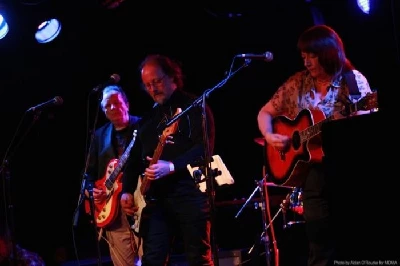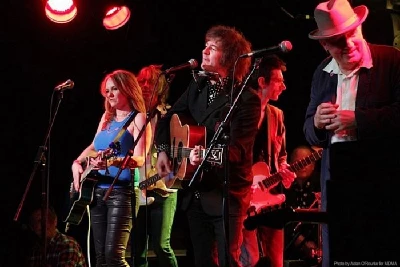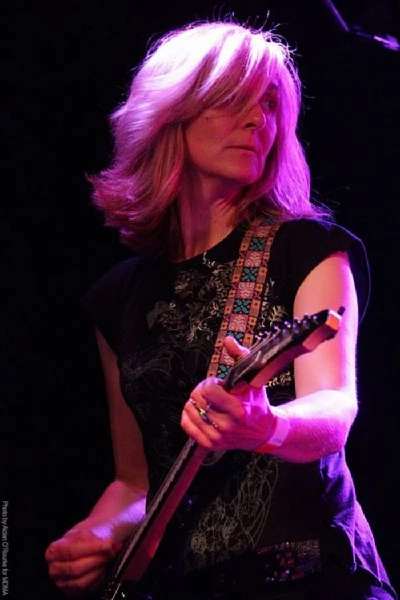published: 21 /
7 /
2016

Nicky Crewe enjoys a fantastic charity fundraising concert at Manchester Academy which celebrates the 50th anniversary of Bob Dylan’s infamous Judas Free Trade Hall concert in which he first played an electric set in the UK in 1966
Article
This is a celebration of the concert when Dylan was accused of being Judas. If you are interested in this review you might have heard some of the radio coverage for this event. You could have been there on the night, back in 1966. Some of the organisers and audience were. You might have bought the bootleg of the concert, wrongly attributed to the Royal Albert Hall concert until C P Lee did his research. You have certainly listened to it. Like me, you probably wish you’d been there. This fiftieth anniversary event is more than a consolation prize.
It combines three things I’m keen on - Manchester, music and recent history.
Bear with me, because there’s some background to be shared to put this particular concert in context.
Firstly it was a fundraiser for an amazing online archive, the Manchester and District Music Archive (MDMA), which has recently been given charitable status. Since its launch in 2003, this user-led and volunteer-run organisation has celebrated Greater Manchester's music and its social history. Currently the archive contains 3270 bands, 598 DJs, 1083 venues and 12321 artefacts contributed by 5436 members. There’ll be more by the time you read this.
C P Lee is a musician and academic, a lifelong fan of Bob Dylan and, in my humble opinion, a national treasure. His knowledge and enthusiasm for music, especially Manchester’s heritage is amazing.
So when MDMA put out a call for artists to get involved and recreate the set list of that significant night, he was one of the movers and shakers.
There’s a lot of significance in some of those musicians involved too. CP Lee playing with Vocal Harum and Gerry and the Holograms. George Borowski appearing with the EPI collective. He’s Guitar George of Dire Straits fame. The Freshies now include Harry Sievey, son of the late lamented Chris Sievey aka Frank Sidebottom (though he couldn’t appear on the night). Andy Kershaw is the MC. Tony ‘Longfellow’ Walsh is the poet. Other artists include Andrew ‘Blind Boy’ Butler, Kevin Hewick, The Speed of Sound, John O’Connell, Poppycock, Jez Kerr, Edwina Hayes, Creature Comfort, Dub Vampire, and Thick Richard and Friends.
There’s an amazing range of experience and talent there, reflecting the enduring appeal of Dylan and his music. The audience are a similar cross section, and there’s even first come seating provided in the venue in recognition that some might need it!
It’s worth saying something about why Dylan’s move from folk to electric was so shocking at the time. I was 12 in 1966. I liked and was discovering all kinds of music. It didn’t occur to me that an artist like Dylan couldn’t change and develop. But I know from friends and family members that he was very much held in awe as part of the folk tradition and protest song movement at the time, and it was a shock that he moved away from it. There were strict rules in folk clubs. 'Traditional' really meant something. Peggy Seeger and Ewan MacColl took a ‘macrobiotic’ approach – sing songs from your geographical area in your own accent. Ironic when you think of MacColl’s name change and Seeger’s origins. I remember behaviour at folk clubs as being very strict. No talking, going to the bar or even the toilet during a set. Like going to the Halle, when the end of a piece was followed by a cacophony of coughing and throat clearing!
But the folk revival had its influence on Dylan, who met and learned from Martin Carthy and others when he came to the UK in 1962. In 1964 he came to Manchester, recording for Granada in Didsbury. His show at London’s Festival Hall was attended by the Beatles and the Stones. Between 1964 and 1966 he had hits with electric songs, but in the UK not all the fans had recognised or appreciated what he was doing and where he was going. Disappointment followed when expectations failed. To call someone Judas still seems deeply shocking to me. That’s a real insult, such a sense of betrayal. Was it because he’d taken the silver, sold out, gone commercial? ‘I don’t believe you. You’re a liar’ was Dylan’s response.
The Hawks, his backing band, were LOUD. The PA equipment they brought over for the tour was beyond most concert goers’ experience and the Free Trade Hall, home to the Halle orchestra, wasn’t designed for that particular acoustic.
Before I headed down to the Academy, I called by the Free Trade Hall, which is now a hotel. I was handed a flyer promoting dinner in their restaurant with a Bob Dylan tribute act. At least they tried to mark the occasion.
The evening’s entertainment began with Tony ‘Longfellow’ Walsh’s amazing poem, ‘And the Dreamers’, commissioned for the MDMA exhibition at the Lowry a couple of years ago and the most concise and intense history of popular culture and music you could ever wish to hear.
Each artist or band had one song each, one chance to be part of the celebration. The stage was managed to perfection as each came on and off, with CP Lee and Andy Kershaw keeping the flow going with anecdotes, banter and snatches of interviews from their late 90s BBC documentary on the concert.
A favourite story involved two girls who wrote a note on a sweet paper and approached the stage to pass it to Dylan. He treated it like a love note, but they’d written to tell him to get rid of the band! Fascinating that fans thought they could protest to this ultimate protest singer. Manchester University Folk Club even made the decision to boycott the concert. Word had got round that the event wasn’t going to be what they thought it should be.
Some of the versions of the set songs took them to new places. The pop punk version of ‘It’s All Over Now Baby Blue’ by The Freshies, Dub Vampire’s amazing ‘Tell Me Momma’ and Poppycock’s reworked ‘Just Like A Woman’, which raised a call of ‘Heresy’, with its new woman’s words. John O’Connell’s Simply Dylan did a stunning version of ‘Desolation Row’ and Edwina Hayes’ ‘Mr Tambourine Man’ was as magical as it can ever be. EPI filled the stage with George Borowski for ‘Baby Let Me Follow You Down’. Gerry and the Holograms, once Frank Zappa’s choice on prime time radio, made an appearance. Everyone got to shout ‘Judas’ at the appropriate moment and to sing ‘Like A Rolling Stone’ at the end. There was even a raffle, in best folk club tradition, at the interval. Prints of Mick Makin’s amazing photos, taken from the audience on the night, were prizes. C P Lee reminded us that people didn’t even know what colour Bob’s hair was back then as all images were black and white.
I’m aware that this Free Trade Hall concert took place the day after the Beach Boys’ ‘Pet Sounds’ was released. I saw the Beach Boys later in 1966, unaware of the difficulties and problems Brian Wilson was having personally and as a musical genius in changing their direction and fulfilling his talents. Brian Wilson is touring Pet Sounds this month. Dylan is coming up to his 75th birthday. So many trail blazers back then. Some are still with us. This is a good time to celebrate and be grateful.
Photos by Aidan O' Rourke
www.aidan.co.uk
Picture Gallery:-



